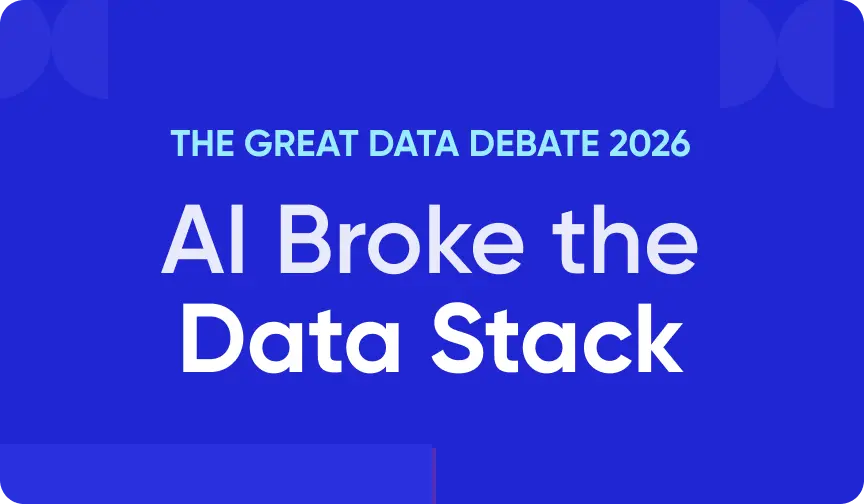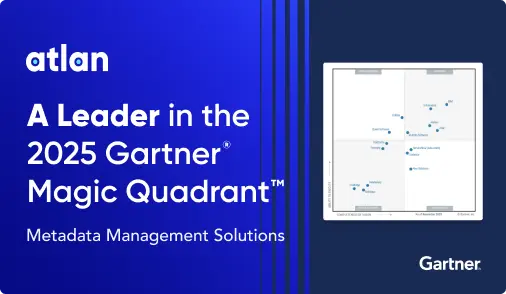Best Informatica Data Catalog Alternative in 2025: A Guide for Data Leaders
Share this article
As organizations race to make their data AI-ready, many Fortune 500 companies are re-evaluating Informatica’s EDC and Axon in favor of more scalable, user-friendly data catalog alternatives that align with today’s cloud-native architectures—without the complexity and cost of legacy platforms.
See a Modern Data Catalog in Action - Start Tour
This guide helps you evaluate your options systematically. You’ll discover what separates effective modern data catalogs from outdated solutions, see real examples from data teams who’ve made successful transitions, and learn how to choose the right platform for your specific needs.
Table of contents
Permalink to “Table of contents”- Why are data teams looking for Informatica data catalog alternatives in 2025?
- What should you look for in a modern Informatica data catalog alternative?
- What makes Atlan the best Informatica data catalog alternative?
- What do industry analysts say about Atlan, the best Informatica alternative?
- Real companies, real results: why teams made the switch
- Is your current data catalog holding you back? Seven warning signs
- FAQS about Informatica EDC alternatives
- Related Reads: Informatica data catalog alternatives
Why are data teams looking for Informatica data catalog alternatives in 2025?
Permalink to “Why are data teams looking for Informatica data catalog alternatives in 2025?”The data landscape has fundamentally changed. 80% of enterprise data now lives in cloud platforms like Snowflake, Databricks, and BigQuery. Yet many organizations are still using data catalogs built for on-premises data centers from the early 2010s.
Here’s what’s driving the search for Informatica alternatives:
The cloud connectivity challenge
Permalink to “The cloud connectivity challenge”Informatica EDC requires Linux gateway agents and 165-200 outbound ports in each Virtual Private Cloud (VPC) to connect to modern cloud warehouses. For context, most security teams prefer minimal port exposure—this extensive requirement creates a massive attack surface that delays projects by months and drives up costs.
Translation for executives: Your security team will push back hard on this setup, creating project delays and budget overruns.
The user adoption crisis
Permalink to “The user adoption crisis”When only 10% of your intended users actually use the catalog, you have a problem. Informatica’s fragmented approach forces users to juggle five or more different URLs and re-authenticate each time just to trace a single data lineage path.
The business impact: Teams create shadow Excel inventories and duplicate data pipelines because the official catalog is too cumbersome to use.
The lineage gap that kills compliance
Permalink to “The lineage gap that kills compliance”Modern data transformations happen inside tools like dbt, Fivetran, and custom ELT processes. Informatica’s scanners capture table-level movements but miss the SQL transforms where the real data processing happens. This leaves you blind to column-level data flows—a critical gap for GDPR, ESG, and AI governance audits.
The executive risk: A single PII trace can take days instead of minutes, inflating your steward headcount and audit risk.
The unpredictable cost problem
Permalink to “The unpredictable cost problem”Informatica’s “Informatica Processing Units” (IPUs) bundle compute and features together, making monthly costs impossible to predict. A single new data source can spike costs by 30%, forcing finance teams to over-buy “just in case.”
The CFO impact: Six-figure capital gets locked into unused capacity because you can’t accurately forecast consumption.
What should you look for in a modern Informatica data catalog alternative?
Permalink to “What should you look for in a modern Informatica data catalog alternative?”Drawing from conversations and documented migrations across 100+ enterprise data teams, here are the critical capabilities that modern catalog platforms must deliver in 2025:
Cloud-first architecture (not cloud-adapted)
Permalink to “Cloud-first architecture (not cloud-adapted)”Look for platforms built from the ground up for cloud data stacks. They should require zero inbound ports and use lightweight agents that connect outbound over HTTPS—clearing security reviews in days, not months.
Real user adoption (not just feature lists)
Permalink to “Real user adoption (not just feature lists)”The best catalog is the one people actually use. Look for platforms with Netflix-style user experiences that integrate directly into tools your team already uses—Slack, Chrome, VS Code, and Teams.
Automated column-level lineage
Permalink to “Automated column-level lineage”Your platform should automatically trace data at the column level across all transformations—from dbt models to BI dashboards—without requiring custom parsers or manual configuration.
Transparent, predictable pricing
Permalink to “Transparent, predictable pricing”Avoid metered models that create billing surprises. Look for flat per-asset pricing that lets your finance team forecast three-year spending with confidence.
Automation that reduces manual work
Permalink to “Automation that reduces manual work”Rule engines should auto-classify PII, assign owners, and certify assets automatically. If your stewards are still manually tagging thousands of columns, your platform isn’t earning its keep.
What makes Atlan the best Informatica data catalog alternative?
Permalink to “What makes Atlan the best Informatica data catalog alternative?”Here’s a side-by-side comparison based on actual user feedback and analyst reports:
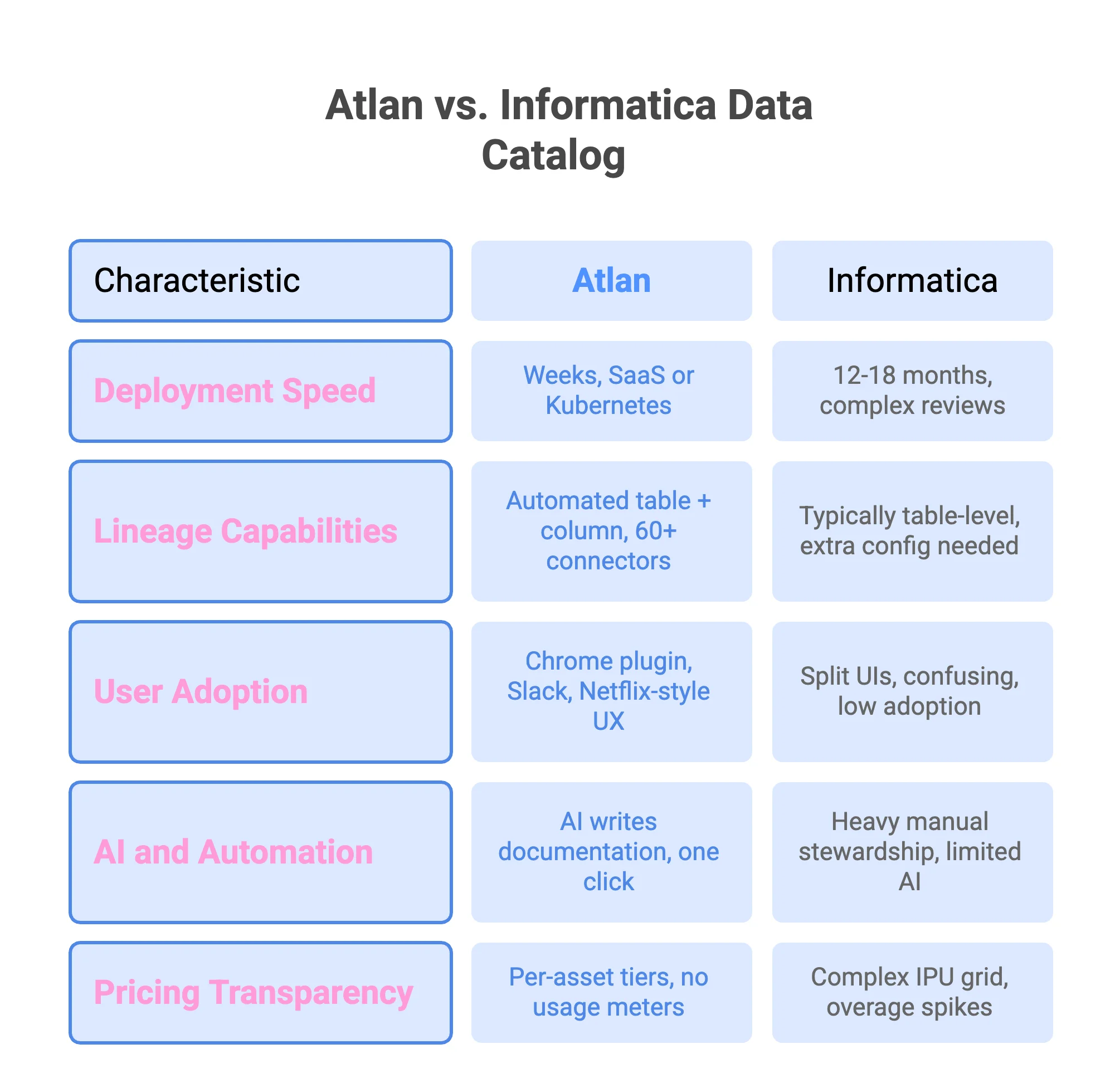
Learn more about kickstarting your journey from Informatica to Atlan - book some time with us today.
What do industry analysts say about Atlan, the best Informatica alternative?
Permalink to “What do industry analysts say about Atlan, the best Informatica alternative?”Industry analysts consistently rate Atlan highly in the data catalog space, recognizing its modern architecture, user-centric design, and ability to support agile, cloud-native data teams.
The Forrester Wave™: Enterprise Data Catalogs, Q3 2024
Permalink to “The Forrester Wave™: Enterprise Data Catalogs, Q3 2024”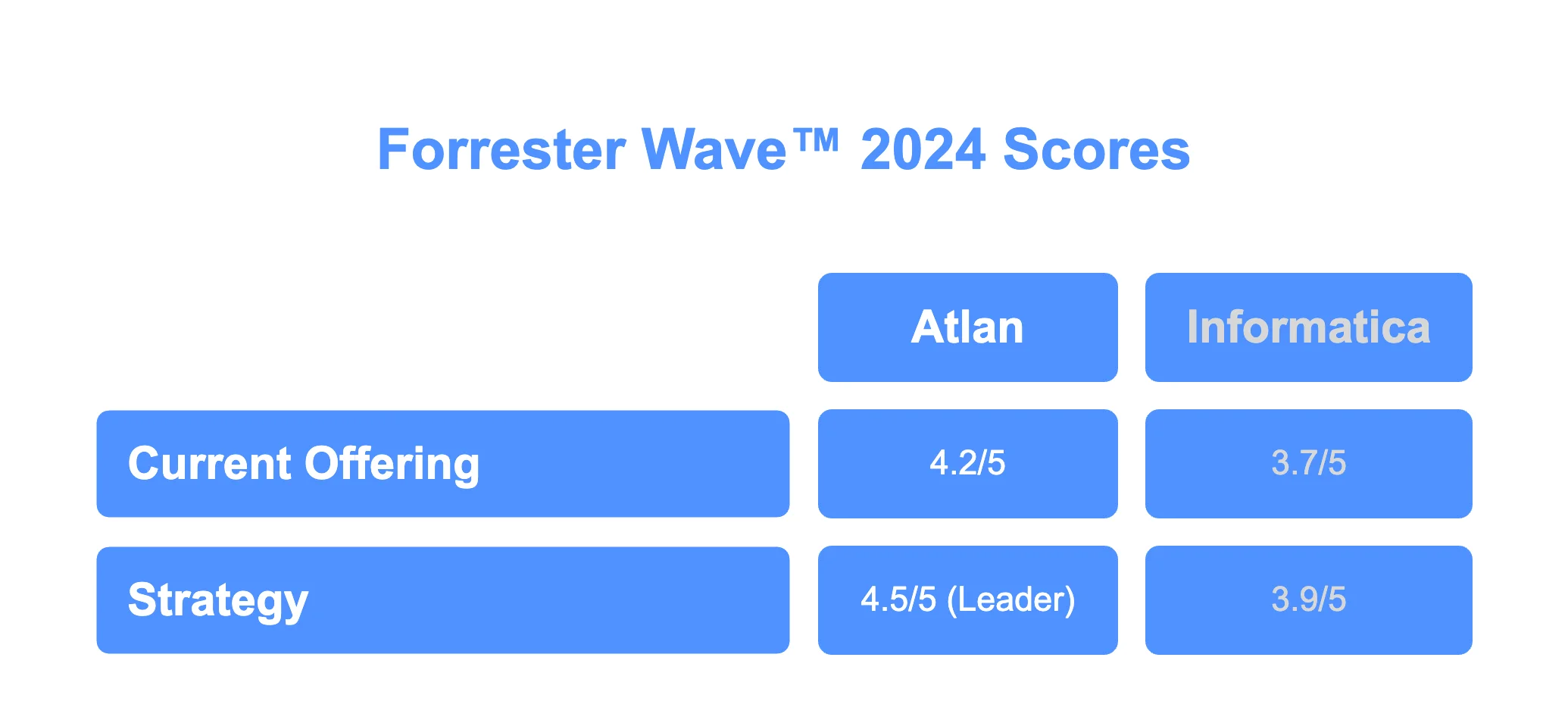
Download full report here.
Gartner Peer Insights – Active Metadata (May 2025)
Permalink to “Gartner Peer Insights – Active Metadata (May 2025)”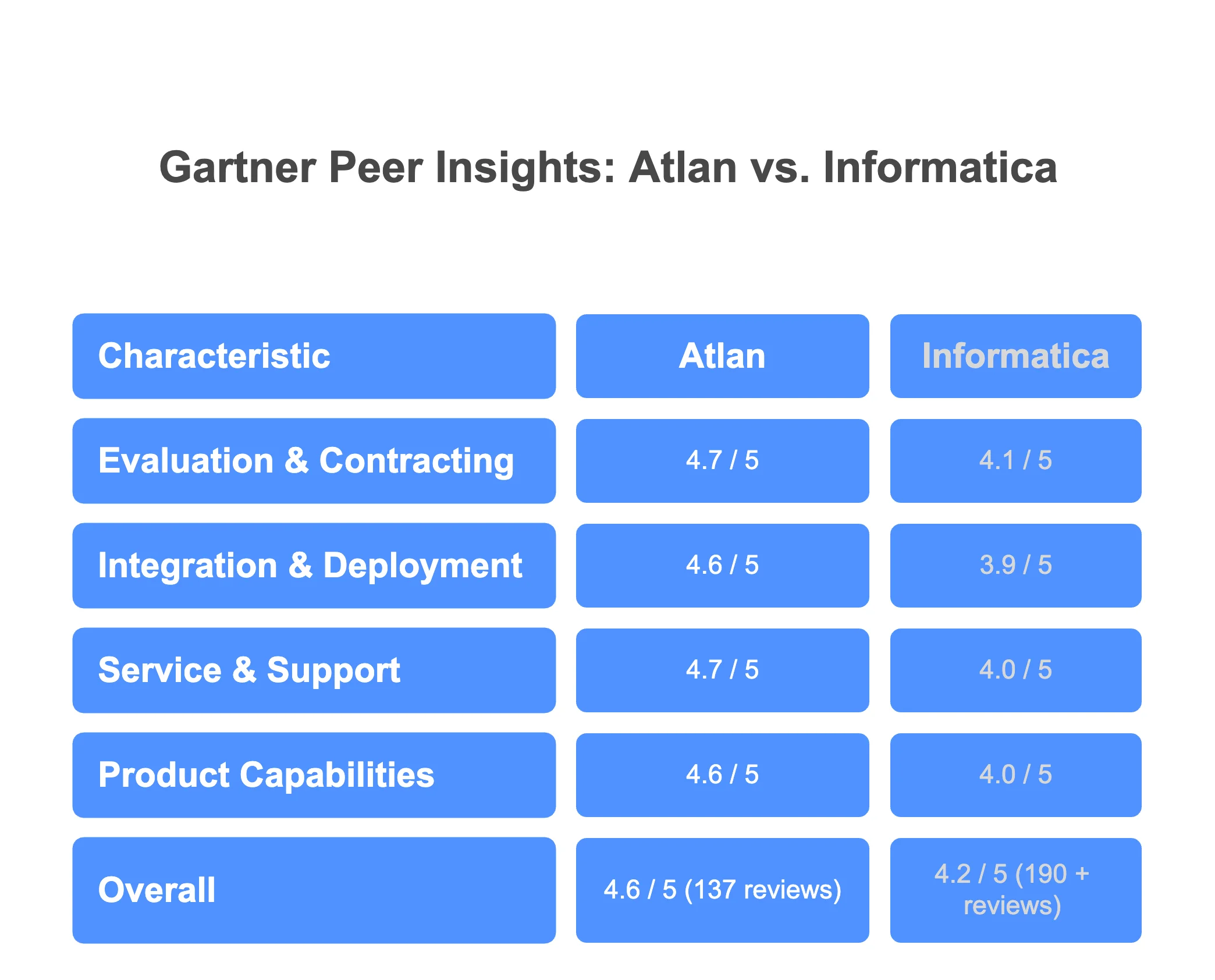
(Source: Gartner.)
G2 Crowd – Data Governance & Catalog (Mar 2025)
Permalink to “G2 Crowd – Data Governance & Catalog (Mar 2025)”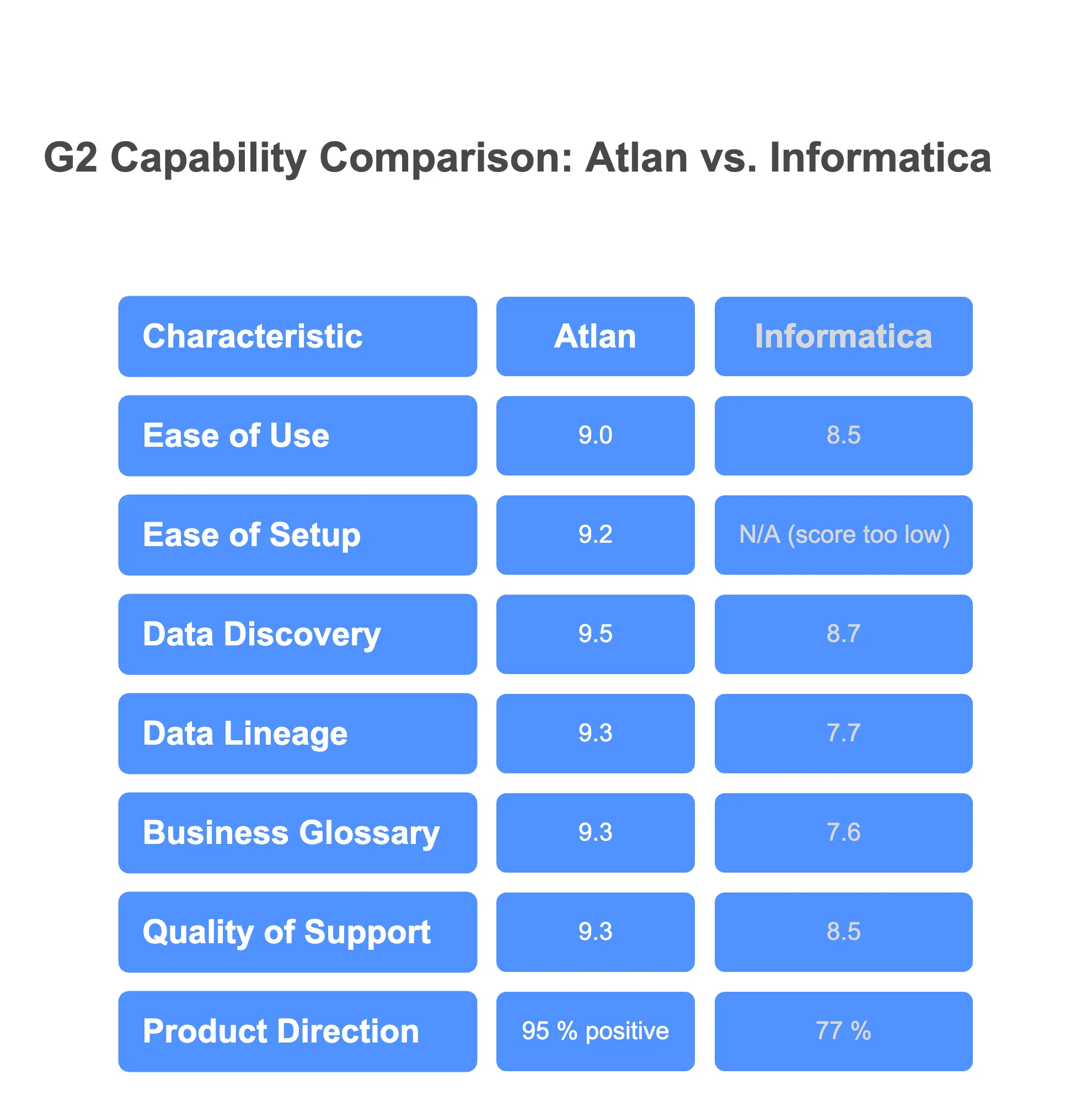
(Source: G2.)
Real companies, real results: why teams made the switch
Permalink to “Real companies, real results: why teams made the switch”HelloFresh: From 10% to 3x Adoption in 3 Months
Permalink to “HelloFresh: From 10% to 3x Adoption in 3 Months”The Challenge: Despite significant manual effort, HelloFresh’s Informatica deployment had extremely low adoption rates.
The Solution: They switched to a modern Informatica alternative, Atlan and achieved:
- 500+ monthly active users within three months
- 3x higher adoption compared to their Informatica peak
- Column-level lineage giving full visibility from source to dashboard
- Role-specific interfaces that addressed unique needs of engineers, analysts, and business users
“With Informatica, adoption was extremely low despite significant manual effort from our team. Within the first three months of using Atlan, we achieved over 500 monthly active users—more than 3x the adoption we saw with previous tools.” - Natalie Hallak, Director of Global Data Management
Porto Seguro: From Frustration to “Fit Like a Glove”
Permalink to “Porto Seguro: From Frustration to “Fit Like a Glove””The Challenge: After a year with Informatica EDC, Porto Seguro couldn’t implement basic features like lineage and business glossary.
The Solution: They found Atlan that delivered:
- Automatic column-level lineage that impressed their CDO
- Native integrations with smooth setup (no integration headaches)
- Intuitive UI that non-technical users could navigate without training
- Open APIs for custom integrations and extensions
- All-in-one platform eliminating the need for additional tools like Axon
“We had Informatica EDC. The motivation to look for a different solution came from some difficulties in implementing certain features like lineage, a business glossary. It was kind of frustrating, and it came to a point where we felt like the technology was kind of blocking us from reaching where we wanted to go.” - Danrlei Alves, Senior Data Governance Analyst
Is your current data catalog holding you back? Seven warning signs
Permalink to “Is your current data catalog holding you back? Seven warning signs”If you’re experiencing three or more of these issues, it might be time to evaluate Informatica alternatives:
- Security Delays: Your security team pushes back on connector requirements
- Low Adoption: Less than 25% of intended users actively use the catalog
- Lineage Gaps: You can’t trace column-level transformations automatically
- Cost Surprises: Monthly bills fluctuate by more than 20% without warning
- Manual Overhead: Stewards spend more time tagging than analyzing
- Integration Pain: Connecting new data sources takes weeks, not days
- Audit Struggles: Compliance traces take days instead of minutes
Learn more about kickstarting your journey from Informatica EDC to Atlan - book some time with us today.
FAQS about Informatica EDC alternatives
Permalink to “FAQS about Informatica EDC alternatives”What should I look for in a modern alternative to Informatica?
Permalink to “What should I look for in a modern alternative to Informatica?”A modern data catalog should offer cloud-native deployment, automated column-level lineage, intuitive user experience, and seamless integration with tools like dbt, Tableau, and Snowflake. Real-time metadata updates, open APIs, and pricing that scales with usage—not arbitrary units—are also key. Most importantly, it should drive real adoption across both technical and business teams.
What happens to our existing Informatica metadata if we switch to a modern alternative like Atlan?
Permalink to “What happens to our existing Informatica metadata if we switch to a modern alternative like Atlan?”Atlan provides migration playbooks that map Axon terms, EDC schemas, and custom metadata into Atlan’s active metadata layer. Most teams are able to migrate their foundational catalog in a matter of days—not months—and can enrich it further using Atlan’s AI suggestions and governance automation.
Does Atlan integrate with Snowflake governance and Databricks Unity Catalog?
Permalink to “Does Atlan integrate with Snowflake governance and Databricks Unity Catalog?”Yes. Tags, masking policies and ownership sync both ways, giving you one catalog for warehouse and lakehouse.
Does Atlan offer the same level of governance and control as Informatica?
Permalink to “Does Atlan offer the same level of governance and control as Informatica?”Yes. Atlan supports robust governance through automated policy tagging, role-based access control, audit trails, and integration with tools like ServiceNow and Jira. It also provides active metadata flows that can trigger real-time workflows for quality issues, privacy tagging, and compliance reporting. The experience is designed to be both more powerful and more accessible than traditional governance tools.
How does Atlan price versus Informatica’s IPUs?
Permalink to “How does Atlan price versus Informatica’s IPUs?”Informatica uses an IPU (Informatica Processing Unit) pricing model, which can lead to unpredictable costs based on usage spikes. Atlan offers transparent, per-asset pricing with no hidden charges for scans, users, or API calls. This makes it easier for teams to forecast budgets and scale their data stack without financial surprises.
Will business users actually adopt a new catalog?
Permalink to “Will business users actually adopt a new catalog?”HelloFresh’s real numbers say yes: > 500 MAUs within three months—triple their Informatica peak—thanks to Slack answers and Netflix-style UX.
Related Reads: Informatica data catalog alternatives
Permalink to “Related Reads: Informatica data catalog alternatives”- Informatica EDC Vs Atlan: What Do Experts and Users Say?
- Alation vs Atlan: What Do Experts and Users Say?
- Alation Replacement for Large Enterprises: Why Atlan Scales Better for Growing Data Needs
- Collibra Alternative: 8 Reasons Why Future-Focused Data Teams Are Choosing Atlan
- Data Catalog Pricing: Understanding What You’re Paying For
- Atlan Pricing: Let’s find the best plan for you
- Alation Pricing: Estimate The Total Cost of Ownership
- Collibra Pricing: Will It Deliver a Return on Investment?
- Informatica Data Catalog Pricing: Estimate the Total Cost of Ownership
- Alation Data Catalog: Is it Right for Your Modern Business Needs?
- Can Collibra Data Governance Meet the Evolving Needs of Your Dynamic Data Strategy?
Share this article




















